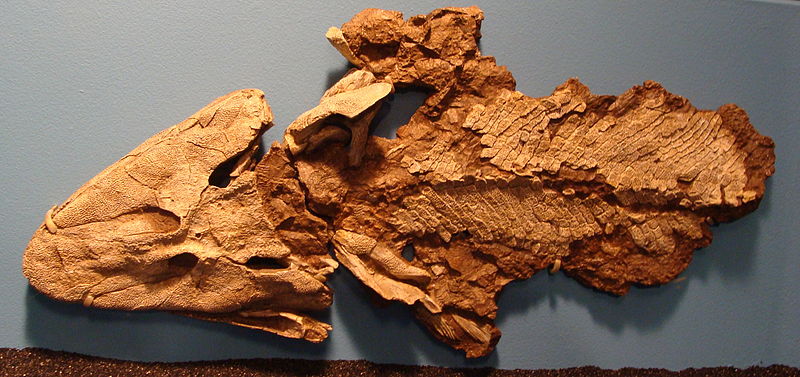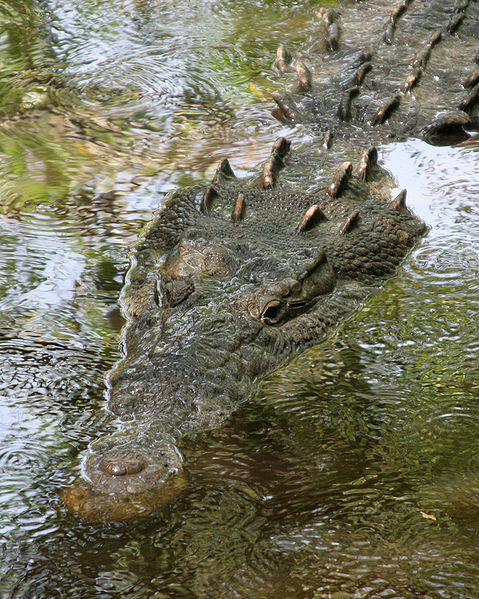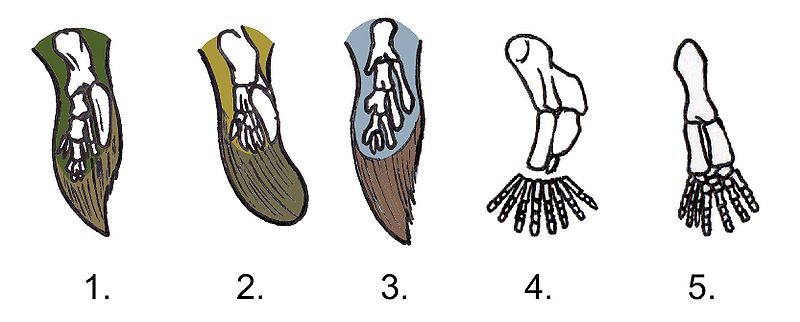How is Tiktaalik adapted to its environment?
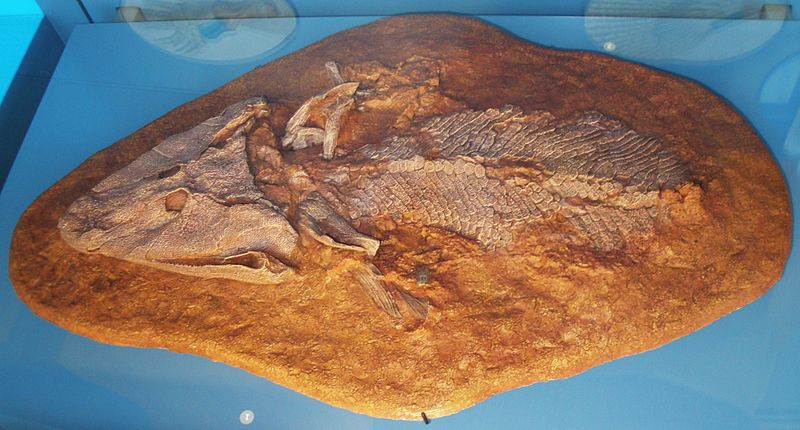 Tiktaalik
looks like a cross between a prehistoric fish and a
tetrapod.
Tiktaalik retained both fish and tetrapod characteristics in its
body structure. Its retained fish characteristics include scales,
fins, and gills (The University of Chicago, 2006). Its tetrapod
characteristics include a neck, ribs, a flat head, which has
dorsally positioned eyes, a fin skeleton, and ear notches (The
University of Chicago, 2006). Tiktaalik began the
transition of organisms living only in the water to terrestrial
living, and its tetrapod synapomorphies were well adapted for the shallow water environment that it is
believed to have lived in.
Tiktaalik
looks like a cross between a prehistoric fish and a
tetrapod.
Tiktaalik retained both fish and tetrapod characteristics in its
body structure. Its retained fish characteristics include scales,
fins, and gills (The University of Chicago, 2006). Its tetrapod
characteristics include a neck, ribs, a flat head, which has
dorsally positioned eyes, a fin skeleton, and ear notches (The
University of Chicago, 2006). Tiktaalik began the
transition of organisms living only in the water to terrestrial
living, and its tetrapod synapomorphies were well adapted for the shallow water environment that it is
believed to have lived in.
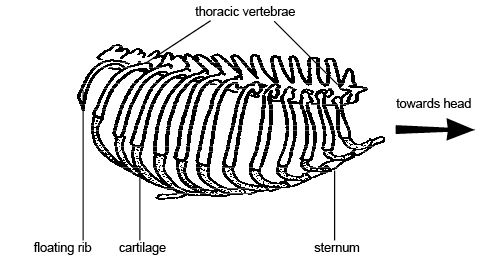 Tiktaalik
had a very strong internal skeleton that was able to support its
heavy trunk upon a solid substrate (Ahlberg and Clack, 2006,
Downs et al., 2008). Tiktaalik also had larger
ribs than the fish it lived among, which also contributed to it
being able to support itself out of the water and its changes in
respiration (Ahlberg and Clack, 2006). Tiktaalik
underwent many cranial endoskeleton changes which point to its
decreased reliance on water pumping for respiration (Downs
et al., 2008). Another adaptation that resulted in a change
of the way Tiktaalik breathed was the loss of an
operculum, which changed
how Tiktaalik respired (Ahlberg and Clack, 2006). The
changes in Tiktaalik's morphology indicates that it
very likely breathed like lungfish. Lungfish still retain gills,
but are also capable of breathing via modified swim bladders
acting as lungs (Owen, 2006).
Tiktaalik
had a very strong internal skeleton that was able to support its
heavy trunk upon a solid substrate (Ahlberg and Clack, 2006,
Downs et al., 2008). Tiktaalik also had larger
ribs than the fish it lived among, which also contributed to it
being able to support itself out of the water and its changes in
respiration (Ahlberg and Clack, 2006). Tiktaalik
underwent many cranial endoskeleton changes which point to its
decreased reliance on water pumping for respiration (Downs
et al., 2008). Another adaptation that resulted in a change
of the way Tiktaalik breathed was the loss of an
operculum, which changed
how Tiktaalik respired (Ahlberg and Clack, 2006). The
changes in Tiktaalik's morphology indicates that it
very likely breathed like lungfish. Lungfish still retain gills,
but are also capable of breathing via modified swim bladders
acting as lungs (Owen, 2006).
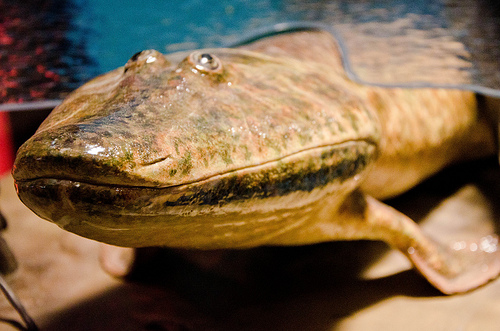 Tiktaalik
roseae also possessed a head and neck that were very different
from other fishes. The head of Tiktaalik was capable of
independent motion, which gave it a lot more head mobility than
other tetrapodmorph fish (Downs et al., 2008). Because
Tiktaalik had a head with independent motion, a neck, a snout
with the ability to snap, and dorsally located eyes, it is inferred
that it hunted very much like a modern day crocodile (Downs et
al., 2008, Ahlberg and Clack, 2006, Shubin et al., 2006).
Crocodiles today hunt by sitting camouflaged and motionless in the
water with their body hidden beneath the surface (Vancouver Aquarium,
2013). When prey gets close enough, the crocodile will snap its jaws
and drag the animal under the water to be drowned and then consumed
(Vancouver Aquarium, 2013). It is likely that Tiktaalik
possessed a lateral line full of sensory receptors along the upper
skin layer, which allowed them to sense movement in the water around
them, much like crocodiles today have (Britton,
2012) . While Tiktaalik may not have hunted as large of
animals as some modern crocodiles do, it is likely that
Tiktaalik hunted small fishes and invertebrates along the
shorelines and shallows where they lived (Owen, 2006).
Tiktaalik
roseae also possessed a head and neck that were very different
from other fishes. The head of Tiktaalik was capable of
independent motion, which gave it a lot more head mobility than
other tetrapodmorph fish (Downs et al., 2008). Because
Tiktaalik had a head with independent motion, a neck, a snout
with the ability to snap, and dorsally located eyes, it is inferred
that it hunted very much like a modern day crocodile (Downs et
al., 2008, Ahlberg and Clack, 2006, Shubin et al., 2006).
Crocodiles today hunt by sitting camouflaged and motionless in the
water with their body hidden beneath the surface (Vancouver Aquarium,
2013). When prey gets close enough, the crocodile will snap its jaws
and drag the animal under the water to be drowned and then consumed
(Vancouver Aquarium, 2013). It is likely that Tiktaalik
possessed a lateral line full of sensory receptors along the upper
skin layer, which allowed them to sense movement in the water around
them, much like crocodiles today have (Britton,
2012) . While Tiktaalik may not have hunted as large of
animals as some modern crocodiles do, it is likely that
Tiktaalik hunted small fishes and invertebrates along the
shorelines and shallows where they lived (Owen, 2006).
Tiktaalik also possessed pectoral fins that were composed of fin rays and able to support the weight of it (Downs et al., 2008, Ahlberg and Clack, 2006). These fins were not quite forelimbs however. The limbs and shoulders of Tiktaalik allowed it to swim, as well as prop itself up on a solid substrate (The University of Chicago, 2006). Tiktaalik could prop itself up by flexing the shoulder and elbow, while simultaneously extending the inter-radial joints (Shubin et al., 2006). Not only were the fins of Tiktaalik well adapted to living in the shallows, but also the distal part of the body to the head was able to flex slightly upward (Ahlberg and Clack, 2006). The fins of Tiktaalik allowed it to live in a variety of different substrates (Shubin et al., 2006).
